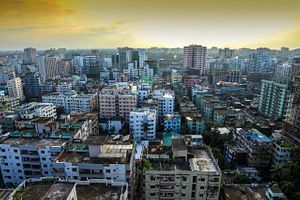Ongoing trade disputes between the United States and China have stymied global markets and shaken the established order. Projected economic growth in South Asia has fallen 1.1 percentage points in just the last six months. Bangladesh, on the other hand, has adapted to the rapidly changing landscape and managed to maintain its impressive record of economic growth.
The Asian Development Bank says Bangladesh has the fastest-growing economy in the Asia-Pacific region. Lately, it’s been closing in on double-digit annual growth in its Gross Domestic Product. The reason: Bangladesh has made enormous strides by finding new markets for its exports and attracting large numbers of foreign investors. It’s also been investing in a variety of modernization projects.
At a time when many countries are looking inwards and closing their doors, Bangladesh is open for business.
Bangladesh can open its doors because of its burgeoning economy. Since 2009, Bangladesh’s economy has grown 188 percent. This year, Bangladesh is on track to post record high annual GDP growth of 8.1 percent, up from 7.9 percent in 2018. By comparison, other South Asian countries, including India, Pakistan, and Sri Lanka, suffered significant dips in GDP growth in recent years.
Yet Bangladesh has continued to thrive. HSBC Bank recently predicted that Bangladesh would be the 26th-largest economy in the world by 2030.
Exports have also increased and diversified. Bangladesh’s exports grew by 4.5 percent in 2018 and is on track to increase by 10.1 percent this year. In addition, Bangladesh is now the fourth largest rice producer, the second largest jute producer, the fourth largest mango producer, the fifth largest vegetable producer, and fourth largest inland fish producer in the world. On top of that – and surprisingly — Bangladesh also exported 12 industrial robots to South Korea and four ships to India.
Ingenuity, adaptation, and modernization have allowed Bangladesh to compete in the global marketplace.
The garment industry remains Bangladesh’s economic backbone, and it too is booming. Thanks to rising demand for Bangladeshi garments in the United States and newer markets in Australia, Canada, India, and China, Bangladeshi garment exports rose 2.7 percent in 2018 and this year will increase 11.5 percent from the year before. Hans Timmer, World Bank Chief Economist for the South Asia Region, said, “In general, what we see in high frequency data is that Bangladesh is doing better than the rest of the region, especially than India, Sri Lanka and Pakistan. We see that in industrial production; we see that in exports.”
Bangladesh is also harnessing the power and productivity of its youthful workforce. Bangladesh’s educational system produces more than 500,000 university graduates every year, and more than 65,000 of the graduates receive training in Information Technology Enabled Services. These graduates are not, however, entering the same job market their parents did. Bangladesh was long a largely rural and agricultural country. Today, young professionals are increasingly urban and digitally savvy. To facilitate this transition, Bangladesh has developed more than 8,000 digital centers across the country to help provide various digital services to its citizens. It has also expanded internet and mobile coverage. More than 110 million Bangladeshis, or two-thirds of the population, have access to the internet.
International investors have taken notice. Since 2018, net foreign direct investment has increased by 42.9 percent. Most of that has gone to the production of electricity, food, and textiles. Top investors come from China, the United Kingdom, the Netherlands, and South Korea. Recently, Saudi Arabia’s energy behemoth, ACWA power, agreed to set up an gas-powered, 3,600 megawatt plant in Bangladesh – compelling evidence of Bangladesh’s growing allure. ACWA will invest a total of $3 billion in Bangladesh’s energy development sector.
Bangladesh has built an economy that’s not only been surviving, but is thriving in a volatile world. Thanks to its young workforce and rapid modernization it has climbed to the top of South Asia’s already fast-growing economies.
Mohammad Ziauddin is Bangladesh’s ambassador to the U.S.

































